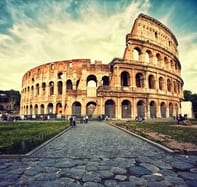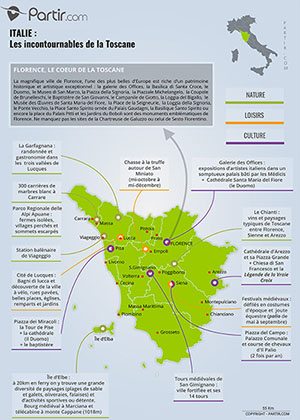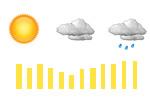: 0 must-see attractions
Golden and green undulating hills dotted with pin straight cypress trees, olive groves and vineyards, villages and thousand-year-old abbeys perched on hilltops: this is Tuscany and its picture postcard landscapes in a nutshell. It's almost enough to forget entirely the sandy beaches along the Tyrrhenian Sea coastline, the Tuscan archipelago islands and the steep mountain reliefs which make up the Apuan Alps, famous for their immaculate marble.
Tuscany is also a myriad of medieval Republican towns, which have been claiming their political and economic independence since the twelfth century. This can be seen in its architecture, with each city having a communal palace symbolising the power of the city-state, fortifications, high towers and prestigious palaces ... Here live families of merchants and craftsmen, organised in arti (sort of guilds), which radiate throughout Europe and the Mediterranean; there are also bankers who finance the kings in Christendom, like the Medici, a family that presided over Florence's destiny for centuries. Then there are the informed patrons, like Lorenzo il Magnifico, who called upon artists, architects and scholars from all over Italy to embellish their city. The home of humanism and the Renaissance, the birthplace of the Italian language, the homeland of Dante, Petrarch, Boccaccio (the "three crowns of literature"), Tuscany - and its regional capital Florence, classified as a UNESCO World Heritage Site - is such a myriad of artistic treasures that it can sometimes make you dizzy with delight.
Here are just a few of its many riches!
Tourist attractions
You may also like
-
Flights to Tuscany
All you need to know before buying your plane ticket
-
Tourist maps
Region, attractions and distance map Tuscany!
-
Hotel or vacation rental?
Find your dream accommodation in Tuscany at the best price...
-
When to go?
Be sure to visit Tuscany at the best time of year!
and why not...
 Roma and Latium
Roma and Latium




